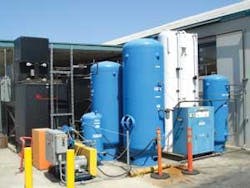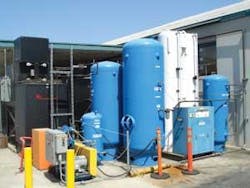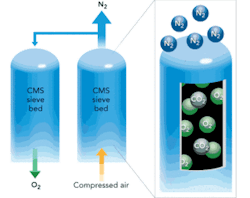Reducing gas costs for cutting stainless
David A. Belforte
On-site nitrogen assist gas generation enables shops that laser cut stainless steel to cut costs
As the use of lasers for cutting sheet metal increased in the late 1980s it became apparent that cut quality, specifically oxide formation, in stainless steel was an issue. The exothermic reaction when oxygen is used as an assist gas, specifically when cutting carbon steels, had been well documented and was commonly used. In this process, oxygen impinging onto the laser beam spot on the metal surface heats the steel, producing an exothermic reaction that increases the temperature of the area to the melting point causing molten metal to be expelled from the beam impingement area by washing down the walls of the cut area. As the metal is ablated away from fresh metal, the end result is a fairly smooth surface but with an oxidized cut edge.
Stainless steel, on the other hand, with its higher melting point, behaves differently and, when quality and thickness of the cut are factors, the oxygen technique is usually an unacceptable method because of the residual oxide formation. To combat this, in the early 1990s, low-pressure nitrogen assist gas was the chosen technique. With the later availability of high-pressure optics that allowed much higher gas delivery pressures, the process became endothermic, essentially an evaporation/ablation process, with no residual oxide formation on the cut edges, yielding an improved quality cut. Because the assist gas in this process performs the function of removing molten steel from the cut area, gas pressure and purity become factors. Higher pressures mean greater gas consumption, which equates to a more expensive operating cost situation. (Nozzle diameter has an even bigger impact on gas consumption because thicker material cutting requires larger nozzles.)
It wasn’t long before the use of nitrogen in addition to oxygen became a common practice, and soon a thriving business supplying nitrogen to laser cutting facilities developed. Nitrogen, delivered in small and large tanks (cylinders and Dewars), became the industry standard. And it was not unusual to drive into a job shop parking lot and see a tall tank of liquid nitrogen adjacent to the building, a sure sign that this company cut lots of stainless steel and other reactive metals and therefore used a great amount of nitrogen.
Air is composed primarily of nitrogen (78%), and air is free. A viable and cost-saving method of obtaining nitrogen is utilizing a nitrogen generator instead of purchasing bulk nitrogen (either liquid or gas). A nitrogen generator takes the free air, separates the molecules and captures the nitrogen that can now be used with the laser cutting equipment. Companies such as On Site Nitrogen have equipment that can produce nitrogen with as little as 0.0005% or 5 PPM of Oxygen. The only cost associated with nitrogen generation outside of the equipment is the cost to run an air compressor that feeds the nitrogen generator. Most companies using this generator experience significant savings by using this process over the more traditional way of purchasing gas from the local supplier. Most plants already have compressed air in place so all that is needed is to pump this into a dryer, then into a nitrogen generator, and then into a storage tank and tapping this storage tank to push it to a booster to raise the pressure. The result is a cheaper source of assist gas for cutting stainless steels.
Companies like O2N2 Site Gas Systems (www.onsitegas.com) recognized the need for nitrogen generating systems for laser cutting, and about 10 years ago it started delivering custom-built systems specifically for the laser cutting industry. The company recognizes how simple it is for shops to make their own nitrogen, at a savings up to 80% over the cost of buying nitrogen. This savings combined with the low installation and operating cost of a nitrogen generator and the always-available gas source (compressed air) are major advantages for those cutting large volumes of stainless steels and other reactive metals.
The company utilizes Pressure Swing Adsorption (PSA) or membrane technology to separate the molecules of nitrogen from air. PSA utilizes compressed air that will be inserted into a pressure vessel filled with Carbon Molecular Sieve (CMS). Under pressure the CMS will separate the molecules of the air, capture the nitrogen for use, and vent the oxygen back to the air where it instantaneously goes back to ambient conditions. The nitrogen is then drawn off to a storage tank. These custom-built generating systems can produce flow rates to 75,000 CFH at nitrogen purity levels to 99.9995%. Systems are available with a Purity Flow Exchange option that allows the user to switch between different levels of nitrogen purity at the touch of a button.
Alco Metal Fab is a Santa Ana, CA, job shop that has been in business since 1948 but was incorporated as Alco in 1962. The company runs four laser systems: three Amada (2–4 kW) and one Bystronic (3 kW). It cuts mostly mild and stainless steel with capacity to 1 1/4 inch thickness.
The company’s main reason for installing a laser was to minimize set up time due to the nature of its business, which features a great amount of short-run orders. With the first laser, the Bystronic, it found that its gas cost was $8,000 per month, running two shifts. When it added a second 2 kW laser (the first Amada) the gas cost jumped to $10–$12,000 per month, primarily because it was using high pressure for cutting. Alco realized that the economics and practicality of using Dewars of nitrogen was not acceptable for the amount of nitrogen that was needed. The company saw the need for a large bulk storage cryogenic tank, to replace the multiple Dewars being used, but the zoning regulations in Santa Ana prevented their use.
In 2005 Alco decided to look at an alternative to bulk gas delivery and found On-Site Gas Systems Inc., and together a system was sized and installed at Alco’s location allowing the company to generate its own nitrogen right on location. Alco calculated that with two machines it could recover its investment in less than 30 months. So for this company the investment in a nitrogen generator over continuing gas delivery and storage costs was a “no brainier”. At the time it took delivery of the nitrogen generator it also added a third laser, so the investment recovery period dropped even further. This unit was installed in 2006 when Alco added an additional Amada laser cutter.
Asked if the On Site generator has the capacity to serve four laser cutters, Ed Hare, a partner in Alco, says the company intentionally oversized the unit during the design phase before it purchased the nitrogen generator so that future laser expansion could be handled. Hare went on to say that the only issue the company encountered is when it had to replace a gasket on a high-pressure pump after 30,000 hours but otherwise maintenance costs have been minimal. The company had selected a 400 psi high-pressure system in order to cut thick stainless steel.
At Alco, two men can run four machines, so labor costs for the amount of material processed are not a major factor when quoting jobs. This gives the company a competitive edge when bidding against shops located in Mexico. For example, an interesting dichotomy, Hare says that Californian and other U.S. companies manufacturing in Mexico buy their metal in the U.S. and when shipping it to Mexico drop it off in Santa Ana, have it laser cut by Alco, and then continue the shipment to Mexico.
When asked about recovery of the investment cost realized by the savings from using cryogenic nitrogen, with its Dewar rentals, Hare says, “What option did we have?”
So, one of the arguments made against laser cutting of stainless steel by non-laser competitors, the high cost of nitrogen assist gas, is no longer a factor in the choice of a cutting process.


